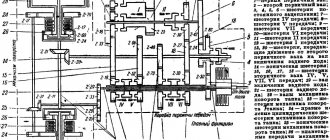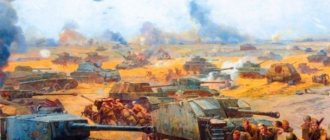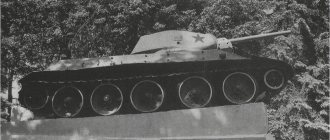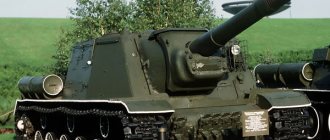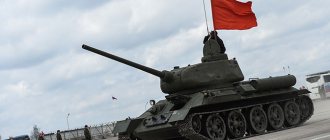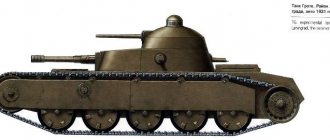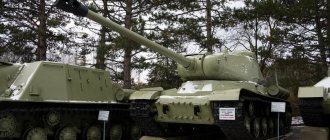The developers continue to introduce premium equipment into the game, but they do it in a rather unusual way. Currently, the T-34E is a Tier 5 Soviet medium tank. At the same time, a similar machine, only without the letter “E”, is already available in the pumpable development branch of the USSR.
What's the catch? The fact is that a car equipped with on-board screens is being tested. In fact, the developers are not offering a fundamentally new tank, but have restyled already proven equipment.
For reference: shielded T-34s were actually in service with the Soviet army. This project was developed at the end of 1941, but subsequently it was decided to abandon additional protection, focusing on the mobility of armored vehicles.
This development received a second life already in 1943, when the need arose to protect equipment from cumulative shells. A total of 46 T-34 units were produced, which were equipped with screens. These vehicles were tested at the front.
Performance characteristics
Let's start the T-34E guide with the fact that the new premium tank will not be able to offer players anything fundamentally new. Here the concept of a pumpable analogue is completely preserved, and significant changes are noticeable only in terms of model visualization. However, let's go over the main characteristics.
So, the shielded T-34 has a safety margin of 500 units. This is the average for a level 5 ST. The developers were clearly greedy with the viewing radius, giving the car farsightedness of 340 meters. Of course, this is not the worst indicator on the level, but considering that we are talking about a new/old medium tank, the developers could make it more “sighted”.
Let's move on to the characteristics of the chassis. The tank weighs 31.9 tons and is powered by a 500-horsepower engine. As a result, the weight-to-power ratio is 15.6 “horses” per unit of combat weight. In fact, this is a very good balance, which allows the tank to accelerate to 56 km/h. Let us clarify that this is an almost absolute record among classmates, so it will not be easy to catch up with a newcomer.
The chassis rotates mediocrely: 36 degrees per minute clearly does not speak in favor of the tank’s maneuverability. If you believe the characteristics declared for the test, then the chassis has frankly weak soil resistance, so on sandy maps the car will noticeably lose speed. Let us add that the T-34E has an excellent camouflage coefficient. For a stationary vehicle this value is 27.7%, while in motion – 20.8%. In fact, the machine can easily operate with passive light, which has a positive effect on the profitability of the equipment.
Let's see how things stand in terms of weapons. The tank is equipped with a 76-mm F-34 gun, model 1943. The barrel penetrates 120 millimeters of armor, removing 110 units of strength with each shot. In principle, this is quite enough to quite comfortably deal with classmates and equipment of a lower level. Let’s add that the T-34 screen tank will not have a reduced level of combat, so it will regularly meet with heavily armored “sevens”.
In this case, you will have to charge gold, which raises the armor penetration value to 150 mm. The gun reloads in 3.8 seconds, which allows you to fire 15 rounds per minute. The estimated DPM will be 1,700 units, which is quite decent for Tier 5 vehicles. The gun is brought down in 2.3 seconds, which, taking into account the reload time, allows you to fire at full alignment. A negative barrel declination angle of 8 degrees will provide a very comfortable game using the terrain.
If we talk about accuracy, then things are sad. The spread radius is 2.43 per hundred, so you will have to give up remote shooting. In addition, the aiming circle will expand as the turret moves and rotates, so the stabilization of the gun also leaves much to be desired.
General information.
The T-34 is not a unique model. The small tank levels never get much attention. But despite this, this model has excellent dynamics and rate of fire, which at some points in the game makes this tank an excellent means of victory. The firepower of the tank is provided by a 57 mm gun and a 76 mm gun; for a more comfortable game, it is recommended to use the 55 mm version. This gun has a penetration of 112 mm, and damage reaches 85 HP. Despite the small damage in total, this is a rather formidable indicator of 5 levels, this provides a high rate of fire of 26 rounds per minute.
Speed is the strong point of this tank. The maximum acceleration reaches 56 mph, and the reverse gear reserve is 20 mph. Quite good indicators of dynamism. It is also worth considering the rather small weight of 31 tons, which accounts for a fairly powerful engine with 500 hp.
The armor of the tank is:
- Body: forehead - 45 mm, sides - 45 mm, pocket - 40 mm.
- Turret: front – 52 mm, side – 52 mm, rear of the turret – 45 mm.
Click and read: Tank Pz.Kpfw. III guide World of Tanks
Recommended modules for the tank.
At small levels, the effect of the modules is not so noticeable, but it is still necessary to install them:
- Rammer – increases the already rapid fire rate of the gun;
- Reinforced aiming drives are necessary, since due to the high rate of fire, aiming is constantly scattered;
- Coated optics - due to its dynamism, the T-34 can be used as an illumination machine.
It is recommended to install standard equipment:
- repair kit;
- fire extinguisher;
- first aid kit
Booking
When considering the shielded T-34, the review will not be complete without armor indicators. Of course, for medium tanks, armor is not as important as maneuverability, but protection is clearly not worth neglecting. So, in the frontal projection of the turret and hull we are offered 45 mm, the armor plates are located at good angles, which not only increases the specific value of the given armor, but also gives a chance for enemy shells to ricochet.
The turret's forehead is partially covered by a gun mantlet, which also increases its protection. There are no protruding elements, such as a weakly protected commander’s cupola, here, but when examining the model, two vulnerable areas immediately catch your eye:
- The turret rotation mechanism seems like a tasty morsel, and when hit by a landmine it will give 100% rotation crit.
- Drive hatch – there is traditionally no armor here, which increases the likelihood of frontal penetration of lower-level vehicles by shells.
Of course, there is also a machine-gun nest on the VLD, which will also be penetrated by all and sundry, but having an attractive target in the form of the driver’s hatch, it is unlikely that anyone will target this vulnerable area.
The side of the turret is protected by 45 mm armor plates, and the hulls are protected by 40 mm thick plates. These values are also maintained for the stern. Here it is necessary to clarify that the premium version of the T-34 is equipped with screens, which gives +16 mm to the thickness of the sides and rear of the turret. However, even with this addition, the tank does not look invulnerable, so it will frankly suffer when getting into high-level battles.
How concrete and plastic armor was installed on the T-34 in WWII
The issue of strengthening the armor of T-34 tanks was returned to several times during the war.
It is difficult to say what exactly was the reason for the start of work on additional reservations - there are many reasons. This includes information about the results of battles in Europe, and data about promising developments in Germany and England (England was not yet an ally), and the desire of the top management to “safeguard” - to get a transition tank before the start of mass production of the T-34M tank.
When there are many reasons, then most likely there is no real reason for concern. This was confirmed by the events of 1941 - until the end of 1941, the armor of the T-34 tank fully met the requirements for such a vehicle.
Nevertheless, the question of increasing the thickness of the armor of T-34 tanks was first raised even before the start of the war. Thus, in the resolution of the Council of People's Commissars of the USSR and the Central Committee of the All-Union Communist Party of Bolsheviks No. 1216−502 “On the production of T-34 tanks in 1941” dated May 5, 1941, the requirement was put forward to “increase the thickness of the armor of the turret and the front frontal plate of the hull to 60 mm.”
According to this document, Kharkov Plant No. 183 and the Stalingrad Tractor Plant were to switch to producing tanks with reinforced armor, and all T-34 tanks produced by that time were to be shielded - that is, equipped with additional, external armor sheets.
The development of the project was completed by July 1941, and from August they wanted to begin implementing this measure, and by the end of the year it was planned to convert 500 tanks, but the outbreak of the war made its own adjustments: work in this direction was stopped, the task of increasing the volume came to the fore production.
© masterok.livejournal.com
No materials on this topic (photos, drawings) have yet been discovered, although it is known that two prototypes were built. But the developments in the field of strengthening reservations were not in vain. The second stage of work to enhance the armor protection of the T-34 tank is usually associated with the appearance of new Pz. III Ausf. J with a 50mm cannon.
An indirect reason could also be a deterioration in the quality of the armor associated with interruptions in the supply of alloying additives. On December 5, 1941, GKO Resolution No. 1062 was adopted. It stated the production of the T-34 tank with frontal armor 60 mm thick from February 15, 1942.
Rolled armor of such thickness was not produced in the USSR, therefore, until the moment when it began to arrive at factories, it was proposed to shield the frontal armor of the hull with armor plates 15 mm thick. However, for some reason, this decision was also canceled by GKO Resolution No. 1333 of February 23, 1942, that is, by the time it began to be implemented.
This is how these regulations were implemented at all three factories that produced T-34 tanks.
Stalingrad Tractor Plant. On January 14, at the test site, representatives of plant No. 264 tested two options for additional armor (in fact, there were more options with slight differences).
Since January 25, plant No. 264 switched to the production of shielded hulls and towers. Until February 23, 1942, 200 T-34 tanks were produced. (Bitter). According to official data, a total of 80 shielded hulls and 109 towers were produced.
The first shielded turret was manufactured on January 21, 1942, and the first building was manufactured on February 25. Several options for applied armor have been developed, applicable to hulls of different designs.
The photographs show chalk marks indicating the exact location of the short tack welds.
© masterok.livejournal.com
By March 1 (apparently the reporting deadline), 8 towers with an armor thickness of up to 75 mm were cast (apparently, not over the entire area, but only in the frontal part). The most rational way to do this is to slightly reduce the internal volume, and not to “spread” the armor on the outside of the tower, so strengthening the tower armor did not affect its appearance in any way.
At the beginning of March, these turrets were installed on regular tanks.
The strengthening of the turret's armor is also associated with the abandonment of the aft hatch for dismantling the gun. Work in these directions was carried out simultaneously. Plant No. 183 (Nizhny Tagil).
The first tanks with reinforced armor were to be released by January 15, 1942. The plant's design bureau decided to begin production of a reinforced cast turret no later than January 20, and from February 1 to completely switch to the production of shielded hulls.
There is no other information about the number of shielded buildings built. The appearance of the hull armor is shown in the drawing. As for the tower, it was planned to strengthen its armor not by adding additional sheets, but by increasing the thickness.
But this does not mean at all that after February 23, 1942, the production of shielded tanks was discontinued. They simply stopped being taken into account as a separate type - the need for reporting disappeared.
A serious advance in armored parts was made, and during the first half of 1942, tanks with conventional turrets and shielded hulls arrived at the front.
One of the photographs shows a T-34, apparently made in Nizhny Tagil, with applique armor and a hexagonal turret, equipped with the characteristic Ural handrails that were introduced in October 1942 (although the tank may have been equipped with them during repairs).
Photographs of Sormovo tanks with screens and handrails are more common, but they appeared here earlier, although the exact date is unknown. The largest number of screened tanks of this period fell near Leningrad. Their photographs on the streets of the city served as the source for the legend about the screening of thirty-fours by plant No. 27 with almost scrap metal, 20 mm thick.
© masterok.livejournal.com
After the battles, many vehicles of this type were transferred to training units stationed near Leningrad.
Training attacks captured by correspondents make up most of the evidence about tanks with padded armor. Some of the shielded tanks ended up in the Polish Army during its formation in the summer of 1943 (a total of 32 T-34 tanks, how many of them were shielded is unknown).
Further research in the field of strengthening the armor of T-34 tanks was carried out by the Central Research Institute No. 48, on the basis of plant No. 112 and the nearby Gorokhovets artillery research site - the proximity to Moscow affected.
Here prototypes and individual armor elements were tested. A new topic of research in 1942-1943 was the protection of enemy anti-tank artillery from cumulative ammunition. Screens were developed that were essentially similar to the German ones.
Photographs of only one model of the T-34 tank have survived, although there are descriptions of other samples, the main differences of which were the angles of inclination of the side shielding sheets (fender liners) and the methods of attaching the side shields.
There were two versions - a lightweight version, in which only the side and fender liners were shielded, and a reinforced version, in which the turret was also shielded. It is impossible not to mention Tsyganov’s reinforced concrete project, tested in 1943. A steel structure with concrete blocks was strengthened around the hull and tower.
Due to the significant mass and, as a result, reduced driving performance, this option was not accepted. By the way, the use of concrete in tank building was not nonsense - the Germans also used it (for example, protection elements for the frontal armor of the StuG IV) - but in much smaller quantities. Already the 50-mm cannon confidently penetrated the T-34 at any distance.
Therefore, the army did not stop trying to somehow additionally armor the tanks in order to escape from enemy shells. Options with applied armor, concrete and ice concrete are known (concrete is good - but very heavy), but the assistant commander of the 102nd Tank Brigade for technical matters, engineer-captain N. F. Tsyganov, went further than anyone else and proposed multi-layer bags made of metal, ceramics and plastics .
© masterok.livejournal.com
The essence of the idea was that the tank was protected by a plastic substance, which the projectile would have to “push” like a liquid, spending a noticeable part of its energy on this.
The idea is somewhat similar to some options for protecting armored ships: they also used compartments filled (not to the top) with water. Sand screen in a sheet iron frame.
- The tower screen consists of 9 separate links: 5 rectangular links, 4 angular sections. The links on the sides have metal gussets 3-4 mm thick; in individual sections of the screen, loops of wire with a diameter of 5 mm are passed through for strength. The hinges are staggered with a horizontal pitch of 200 mm and a vertical pitch of 100 mm. The links are bolted to angles welded to the tower.
- The housing screen consists of 20 separate links: 10 side links with a thickness of 200-300 mm. 2 front links 200−220 mm thick. 2 lower front links 200 mm thick. 2 corner front links 200mm thick. 2 rear links 200 mm thick. 2 rear corner links 200mm thick. The links are bolted to angles welded to the body. Each link consists of a frame of sheet iron filled with sand mixed with a resinous substance.
In general, without going into details, at the beginning of 1943 the question of strengthening the armor of the T-34 tank suddenly arose. This happened in connection with the rearmament of the Wehrmacht with new types of tank and anti-tank guns.
© masterok.livejournal.com
It is clear that strengthening the armor of domestic tanks with shielding was the fastest solution. But on this obvious path, tank builders were faced with an acute shortage of rolled armor, because at the beginning of 1943 there was a shortage of not only thick 45-75 mm, but also thin 10-30 mm armor plates.
Therefore, in the spring of 1943, they again returned to the idea of strengthening the armor of already manufactured tanks through the use of reinforced concrete.
Joint research by NII-48 and OKB-43 showed that simply applying a reinforced concrete pad with a thickness of only 23-40 mm to the surface of a tank’s armor works not only as ordinary additional armor, but when a projectile hits at a relatively high impact angle, it breaks off and does not give the armor-piercing core “bite” so that the projectile rotates towards the normal upon penetration.
Thus, the applied layer of reinforced concrete increased the tendency of a blunt-headed projectile to ricochet... However, the concrete pad could only be applied to the surface of the armor by hand and had to be subjected to complex drying technology, so this method of increasing armor was considered unequal to the expected results.
© masterok.livejournal.com
Therefore, a group of VAMM Academy students under the leadership of Tsyganov N.F. (our old friend, the author of the BT-IS and BT-SV tank projects) developed two schemes for reinforcing the armor - with a concrete pad directly adjacent to the armor plates of the tank and installed with a gap.
These schemes differed from their analogues in that enhanced armor was obtained by installing special removable or permanent formwork on the tank hull and pouring it with concrete, followed by compaction.
In addition, for use in winter conditions, NII-48 was proposed to strengthen the armor of the tank with ice concrete, by installing a wooden frame on the tank hull and filling it with a mixture of gravel, sand and wood sawdust, abundantly watered with water in the cold.
The use of such pads made of ice concrete 80 mm thick led to the fact that the sides of the T-34 were not penetrated by the German 75-mm anti-tank gun RaK 40 from a distance of even 300-400 m. In fact, people do not even try to look carefully at the photographs, because even A quick inspection will tell us that these are two different tanks.
Features of the game on the T-34 shielded
In general, when playing on this machine, you need to start from really strong characteristics that will allow you to realize the potential of this machine with maximum efficiency. Firstly, do not forget about the speed values, which allow the team to highlight, quickly change the direction of the attack and return to the rear to protect the base.
In general, a medium tank should be constantly on the move if the player is not going to turn into a static firefly. By the way, this type of behavior in battle also has a right to exist. The vehicle has an excellent stealth factor, so when it gets to the “sevens” it can easily stand in double bushes, receiving experience and credits for the damage caused by its teammates.
Secondly, the car is equipped with on-board screens, which gives an additional advantage on city maps. In particular, once in the TOP of the command list, the T-34E can quite effectively tank in a diamond formation, turning into a heavy tank. Of course, this trick won’t work with level 7 vehicles, but it will work quite well against classmates.
At the same time, in any situation you need to try to cause damage, which will allow you to replenish the game treasury with silver credits.
Korean War
During the fighting in Korea (1950-1953), the T-34-85 tanks proved themselves to be the best: maneuverable, unpretentious in operation and repair, they enjoyed the well-deserved love of tankers.
First, the American M24 Chaffee met with the T-34-85. In the first battle, the US military lost two M24s, but the North Koreans had no losses - the Chaffee guns could not hit the armor of Soviet tanks. A rather rare case was also recorded - the destruction of an aircraft by a tank. When four F-80C Shooting Star fighter-bombers came to attack the column of North Korean troops, the seemingly defenseless thirty-fours opened fire on the planes from their 85-mm cannons with fragmentation shells. One of the outfits exploded in front of the wingman’s nose, fragments pierced the gas tank, and the F-80C Shooting Star caught fire. A minute later he exploded, the others chose to retreat.
The crew of the North Korean T-34-85 that destroyed the American F-80C Shooting Star jet fighter on July 3, 1950
Tankers of the 105th Tank Brigade, whose training was personally supervised by Kim Il Sung
The T-34-85 did not always emerge victorious from the battle: the use of 3.5-inch “super bazookas” and aircraft caused heavy losses to tankers
Results
Summarizing the above, let's see what the T-34E can offer players. Let's start with sweets. The positive characteristics of the technology include the following:
- Speed is an absolute plus, which some LTs may envy.
- DPM - depending on your luck, but the stated 1,700 damage looks good.
- Review is not the best, but not the worst indicator for its level.
- Screens provide some advantage, and most importantly, do not affect the mobility of the machine.
Flaws:
- Accuracy - the spread really looks very sad.
- Armor - shielded sides do not save the picture as a whole: the tank can penetrate quite comfortably.
- Maneuverability and dynamics are the key parameters that allow you to spin your opponent.
It remains to be assumed that the T-34E will be awarded for some achievements or will become a prize for completing tasks in a game event. Considering that the equipment is practically no different from the pumped-up analogue, there will obviously be few people willing to purchase it in the store.
Advantages and disadvantages of the T-34 E
As was already said at the very beginning, our tank can be called balanced. However, it is necessary to highlight the most important weaknesses and strengths, because this will make it easier for you to understand what you can do in battle and what is best avoided. Pros: •Additional reservation in the form of screens; •Good mobility; •Good armor penetration; •Good CSA; •High maximum speed.
Cons: • Still poor security of the case; •Frequent crits of crew members; •Poor visibility; •Low one-time damage; •Mediocre stabilization and accuracy.
Near East
In the Middle East, during a series of Arab-Israeli wars (1948-1982), the T-34-85 had to face a variety of opponents - from the “familiar” German PzKpfw.lV to the American Shermans, French AMX-13 and English Centurions.
To increase the firepower of the T-34-85, the Egyptian military decided to use Soviet 100-mm BS-3 guns, whose armor-piercing and cumulative shells hit any Israeli tank at a distance of up to 1000 meters
To support the infantry, the T-34/122 self-propelled guns were used, created by combining the T-34-85 tank and the 122-mm D-30 howitzer
However, most meetings between Egyptian tank crews and Israeli tank crews ended sadly for the Arab tank crews. In the photo - a T-34-85 shot down in Sinai
T-34-85 abandoned in the desert after a 6-day war
A damaged Syrian T-34-85, an improvised anti-aircraft turret with a DShK heavy machine gun is visible on the roof of the turret
